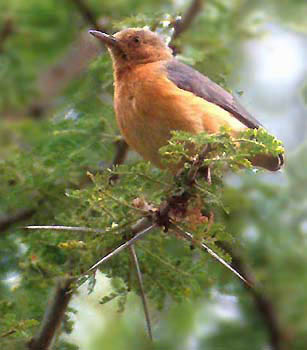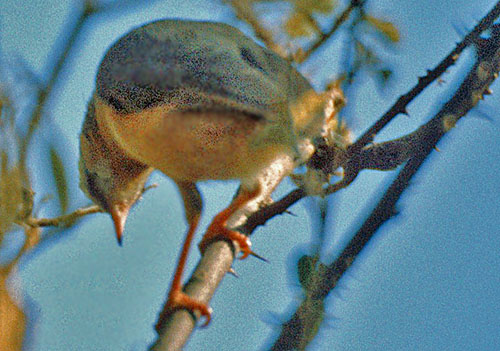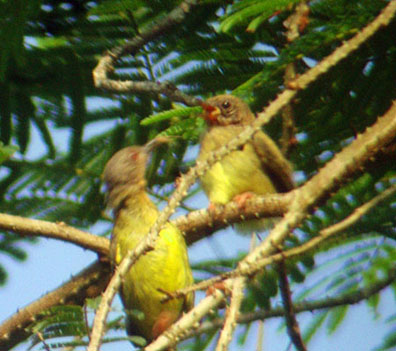
a web page by Don Roberson |
AFRICAN WARBLERS Macrosphenidae |
||
|
||
 "Clinging to a lichen-covered rock wall, a Rockrunner (left) briefly basks in the African sun. An endemic to rocky habitats in Namibia in southwestern Africa, this interesting and unique bird has long been an enigma." That was the opening line when this page was first created in 2005 — at a time that this Family had not even been formally described. This update is in 2021, but it could be worthwhile to relive the past, just to see how far we've come. Accordingly, the 2005 opening continues: "Clinging to a lichen-covered rock wall, a Rockrunner (left) briefly basks in the African sun. An endemic to rocky habitats in Namibia in southwestern Africa, this interesting and unique bird has long been an enigma." That was the opening line when this page was first created in 2005 — at a time that this Family had not even been formally described. This update is in 2021, but it could be worthwhile to relive the past, just to see how far we've come. Accordingly, the 2005 opening continues: "Just a couple years ago, the usually practical Dickinson (2003) followed Olson (1998) and merged this the Namibian endemic into the genus Chaetops [Rockjumpers]. Many recent books and checklists even use the ridiculous name 'Damara Rockjumper' for Rockrunner. Nothing could be further from the truth. Rockjumpers are an ancient African lineage whose only relative are the Rockfowl [Picathartidae], and even they are separated by over 31 million years of evolution. In contrast, Rockrunner evolved among the Old World warblers that split off from the rest of the sylvids about 30 millions years ago (Beresford et al. 2005). But perhaps we are getting ahead of the story . . . " "The great Sylvoid assemblage is crumbling. Recent research, much of it based on DNA analysis, has shown that the Old World Warblers [Sylviidae] did not all evolve from the same ancestor. Indeed, the 400 or so species once considered Old Warbler Warblers may actually belong to a dozen different lineages which may, pending further research, warrant family status. Already we know that the genus Sylvia (with its whitethroats and numerous 'warblers') are actually babblers (Sibley & Ahlquist 1990, Barker et al. 2002). It is now generally agreed that the cisticolas and allies [Cisticolidae] are a separate family of more than 100 species (Sibley & Monroe 1990, Dickinson 2003). Even more recent studies have shown that the megalurid grassbirds likely deserve family status [Magaluridae], as do a set of Malagasy Warblers (e.g., Cibois 1999, 2001, Schulenberg 2003, Barker et al. 2004). These changes had pared down the 400+ 'Old World Warblers' to about 225 species. Now a new study (Beresford et al. 2005) sets apart yet another group: 18 species of African warblers in 6 genera." So that's the way the story read in 2005. Now, 16 years later, the Macrosphenidae is well-established. It has grown to 19 species by the addition of Grauer's Warbler Graueria vittata of the Albertine Rift. The Macrosphenidae brought together a set of rather unlikely species but related by ancient genetics and evolution. Rockrunner (above) is an elusive rock specialist of arid northern Namibia than vaguely recall a grasswren (Amytornis) of Australia. Another is Cape Grassbird (below), a largish warbler that is a shy songster of unique fynbos habitat around Cape Town, South Africa. The family now includes these two plus 9 species of Crombec (Sylvietta), 5 species of longbill (Macrosphenus), Mustached Grass-Warbler Melocichla mentalis, and Victorin's Warbler Cryptillas victorin. |
||
 |
||
 This new grouping of African warblers was an eclectic assemblage of birds, and not anticipated. Beresford et al. (2005) call the "Spenoeacus group," noting it was "not predicted" by traditional classifications. It is, they say, a "novel clade [that is] relatively basal within the Sylviodea, [and] sister to more than 1000 species" of Old World passerines. They did not propose a family name, but they called them "evolutionary enigmas." Christopher Tayler tells me that Macrosphenidae Wolters 1983 is available, so I used that name in 2005. The genus Macrosphenus belongs to the African longbills, and Yellow Longbill M. flavicans is among the African Warblers (Beresford et al. 2005). The genus Macrosphenus was created for it in 1859; the name Macrosphenidae is appropriate for the family. This new grouping of African warblers was an eclectic assemblage of birds, and not anticipated. Beresford et al. (2005) call the "Spenoeacus group," noting it was "not predicted" by traditional classifications. It is, they say, a "novel clade [that is] relatively basal within the Sylviodea, [and] sister to more than 1000 species" of Old World passerines. They did not propose a family name, but they called them "evolutionary enigmas." Christopher Tayler tells me that Macrosphenidae Wolters 1983 is available, so I used that name in 2005. The genus Macrosphenus belongs to the African longbills, and Yellow Longbill M. flavicans is among the African Warblers (Beresford et al. 2005). The genus Macrosphenus was created for it in 1859; the name Macrosphenidae is appropriate for the family. The five species of longbills are mostly small forest birds with longish bills and tails, and are mostly very drab in plumage. They tend to be shy but vocal. I was able to photograph Gray Longbill (right) from a canopy walkway in prime lowland forest in Ghana. It usually forages in pairs or small groups, and from all elevations of the forest: from undergrowth to lower canopy, which is where we found this one bathing in a big leaf high above the forest floor. |
||
The remaining monotypic genera are a diverse bag of African endemics. Moustached Grass-Warbler (left) is a shy songster, but ranges from west Africa to east Africa, frequenting thick cover and rank herbage along streams from sea-level up to 2500m (=8200') elevation. It (like Cape Grassbird) is a mimic with a loud carrying vocal repertoire. Victorin's Warbler Cryptillas victorini , traditionally placed with many other species in Bradypterus, is another Cape of Good Hope vicinity endemic. It lives in pairs in thick undergrowth along gulleys and streams, and is loud and vocal, but is exceptionally difficult to see as in runs mouse-like through the thickets. Grauer's Warbler Graueria vittata is another skulker in montane forests of the the Albertine Rift (the home of the Mountain Gorilla) in Uganda, Rwanda, Burundi and DR Congo, staying within the dense understory and vines. |
||
Northern Crombec (below left) is also a thornscrub species, but it even drier and more desert-like conditions than the thick thorn-scrub inhabited by Red-faced. Northern Crombec is found a wide set of brushy habitats south of the Sahara, from west Africa to northeast Africa, including mangroves in west Africa and "farm bush" (Bairlein 2006). Yet others might be labeled as "forest crombecs," which sometimes join mixed-species flocks in central African lowland rainforests. One of those is Lemon-bellied Crombec (below right), a tiny, short-billed and exceedingly short-tailed species from west and central Africa. It forages as high up as the canopy tops of tall trees. This adult is feeding a fledgling in the sub-canopy. |
||
|
||
Photos: The Rockrunner Achaetops pycnopygius was in Waterberg NP, northern Namibia, on 27 July 2005. The Cape Grassbird Spenoeacus afer was at Jonker Dam near Nordhoek, South Africa, on 3 July 2005. The Gray Longbill Macrosphenus concolor was viewed from the canopy walkway in Kakum NP, Ghana, on 2 Dec 2013. The Mustached Grass-Warbler Melocichla mentalis was Kalkapa NP, Ghana, on 29 Nov 2013. The Red-faced Crombec Sylvietta whytii was in Tarangire NP, Tanzania, on 27 July 2002. The Northern Crombec Sylvietta brachyura was at Lake Baringo, Kenya, on 17 Nov 1981 (from a digitized slide). The single Lemon-bellied Crombec Sylvietta denti was feeding young in Nsutu Forest, Ghana, on 6 Dec 2013 (a digiscoped effort). All photos © Don Roberson; all rights reserved. Bibliographic note: There is no "family book" covering the African warblers; indeed, as pointed out above, there was not a scientific consensus that this actually was a family until fairly recently. Volume 11 in the Handbook of the Birds of the World series treating them as Old World Warblers '"Sylviidae" (Bairlein 2006), but for convenience only. Literature cited:
|

 Nearly half of this new family are crombecs. All crombecs are short-tailed and rather short-billed active birds of a variety of wooded habitats. A number, like Red-faced Crombec (right), are well adapted to dry thorn-scrub (note the spikes on the bush), but also Acacia savanna and Brachystegia woodlands. It ranges from Ethiopia to Zimbabwe.
Nearly half of this new family are crombecs. All crombecs are short-tailed and rather short-billed active birds of a variety of wooded habitats. A number, like Red-faced Crombec (right), are well adapted to dry thorn-scrub (note the spikes on the bush), but also Acacia savanna and Brachystegia woodlands. It ranges from Ethiopia to Zimbabwe. 
